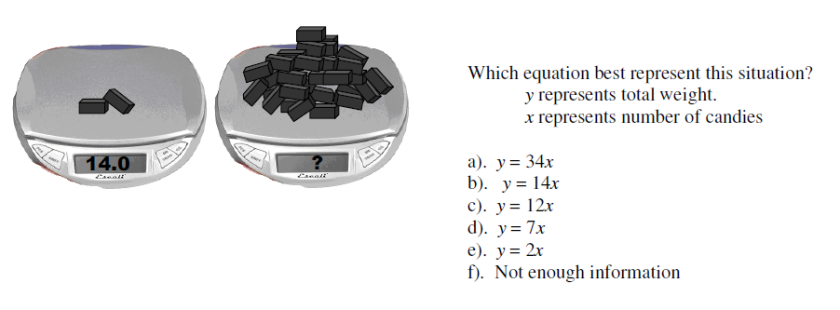OK, the following may rate as one of my best test questions ever. It might take you a second to see the point:
If you don’t get it yet, compare it to this alternate version:
By now you’ve probably seen what I’m getting at: the answer to #1 is “Not enough information”, because there’s a jar there, so the weight per candy is not 7 grams.
Let me share the struggles that led to this idea, and the way this approach will underpin my teaching of linear functions next year:
First of all, I want to continue to make my math real-world (even if nobody at Dan Meyer’s blog can articulate why), but too often that means students have to wade through lots of WORDS to understand a question or task. This is especially daunting for English Language Learners, and I’m working on meeting their needs better. So I need to find ways to capture the essence of concepts and story problems with mostly pictures and a minimum of text.
Secondly, my students often have a hard time seeing why rates are often calculated as (y2 – y1)/(x2 – x1) instead of y/x. With a good context like Domino Effect by Mathalicious, students will discover the idea for themselves, and they’ll be able to memorize it and apply it in real-life situations that obviously give them 2 points. But I’ve always taught direct variation at the end of linear functions, as a special case after the main concept…and after that lesson, some students revert to calculating slope as y/x. They can’t distinguish cases when you need to subtract first from cases when you can just divide.
So instead of teaching direct variation last, next year I’ll teach it first, as the introduction to linear functions. Since they won’t know (y2 – y1)/(x2 – x1) yet, we’ll just start by sorting situations into 2 categories: ones in which you can find the rate (not “slope”–that word won’t exist for us yet) by dividing y/x, and situations in which that makes no sense. We’ll make predictions for new situations in the first category by writing proportions, writing equations of the form y=kx, drawing graphs that pass through the origin, etc. And mixed in with all of that practice will be situations in which direct variation and proportionality don’t work:
(The bar itself weighs something here).
Once we’ve really hammered the idea that there are 2 categories of linear scenarios, ones in which the rate is just y/x and ones in which it’s not, we can finally do Domino Effect and figure out how to deal with the second category. As an aside, I do need to find more 3-Acts that are simple linear scenarios and are still enticing for students. If anybody knows of some, please tell me in the comments. I tried Dan Meyer’s Pencil Sharpener task, which he seems to have taken down from 101q’s, but it gave me a really poor prediction. That’s no good, because early in the year I want my students to feel impressed by their new ability to predict things.
As a final note, I think even before starting the direct variation lesson, we might use Simpsons Sunblock to get students thinking about proportions. In the past, they’ve tended to make their predictions by writing and solving a proportion (or at least informally by doubling the x- and y-values from a particular point in their data table to predict the needed values). Then when we formally introduce the concept of proportionality/direct variation, we can return to Simpson’s Sunblock and talk about how the method they already used there was an example of it. And we can translate the proportions they used into direct variation equations.
Yay! Why is it that March is always when I realize what I should have been doing in September/October?



Good move there with those two images. Took me a second myself.
FWIW, I never developed Pencil Sharpener into a task. Just some #anyqs fodder on the blog back in the day.